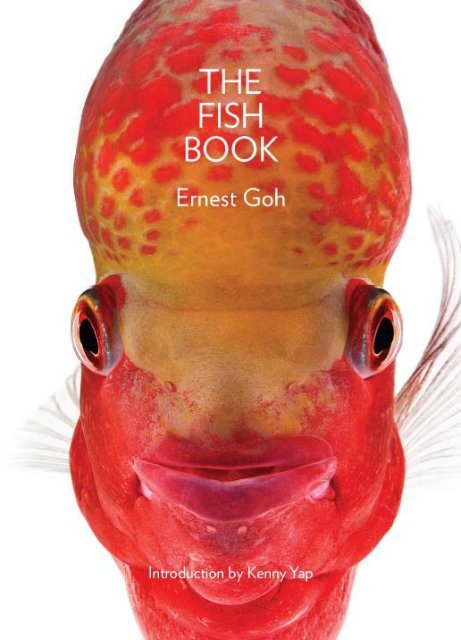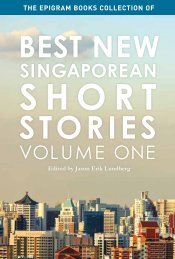View Sample - Epigram Books
View Sample - Epigram Books
View Sample - Epigram Books
Create successful ePaper yourself
Turn your PDF publications into a flip-book with our unique Google optimized e-Paper software.
The Fish Book
The<br />
Fish<br />
Book<br />
Ernest Goh
First Edition<br />
Copyright © 2011 <strong>Epigram</strong> <strong>Books</strong><br />
Wee Editions is an imprint of <strong>Epigram</strong> <strong>Books</strong><br />
Photographs copyright © 2011 by Ernest Goh<br />
Introduction copyright © 2011 by Kenny Yap<br />
Cover design by Andy Koh<br />
All rights reserved.<br />
Published in Singapore by <strong>Epigram</strong> <strong>Books</strong><br />
www.epigrambooks.sg<br />
National Library Board,<br />
Singapore Cataloguing-in-Publication Data<br />
Goh, Ernest, 1979-<br />
The fish book / Ernest Goh. – Singapore :<br />
<strong>Epigram</strong> <strong>Books</strong>, 2011.<br />
p. cm.<br />
ISBN : 978-981-08-8360-7<br />
1. Ornamental fishes –<br />
Singapore – Pictorial works.<br />
I. Title.<br />
SF457<br />
639.34 -- dc22<br />
OCN731617904<br />
To Ma, for everything<br />
No part of this<br />
publication may<br />
be reproduced or<br />
transmitted in any<br />
form or by any<br />
means, electronic or<br />
mechanical, including<br />
photocopying, or<br />
by any information<br />
storage and retrieval<br />
system, without the written<br />
permission of the publisher.<br />
First Edition<br />
10 9 8 7 6 5 4 3 2 1
introduction<br />
A Thing of Beauty, a Joy Forever<br />
I can still remember buying my first goldfish for 50 cents with savings<br />
from my pocket money. I was seven years old. I happily took it home,<br />
broken tail and all. To me it was a thing of beauty.<br />
Since then, the colourful world of freshwater fish has been my pride<br />
and joy. I am known amongst my friends and in the business world as<br />
Kenny The Fish. Perhaps this is not unexpected having been raised in a<br />
family that rears and exports ornamental fish for a living.<br />
Hobbyists often ask me what makes a good fish. My answer is that a<br />
good fish is simply one that you like. It does not matter what is the latest<br />
trend, or whether your fish has any imperfections. The true hobbyist does<br />
not go with the flow. Take those who rear Dragon Fish, for example.<br />
They continue to stay true to their faithful Dragon Fish no matter what is<br />
popular at the time. The adage “beauty lies in the eyes of the beholder”<br />
has never been more apt than in the case of ornamental fish.<br />
For centuries, keeping ornamental fish has brought pleasure to<br />
people young and old, all over the globe. Fish keeping in Southeast<br />
Asia was greatly influenced by the first wave of Chinese traders and<br />
immigrants into the region in the mid 19th century. The keeping of pla<br />
kat or fighting fish in Siam (Thailand today) started before the 19th<br />
century when locals kept them for fighting competitions. It became so<br />
popular that the King of Siam started licensing and collecting these<br />
amazing fish.<br />
Recent research has shown that the companionship and unconditional<br />
love and support that pets provide are truly invaluable. Case studies<br />
all over the world have also shown that pets can even help their owners<br />
recover and recuperate from serious illnesses.<br />
Apart from these reasons, ornamental fish are simply a sight to<br />
behold—the plethora of shapes, colours and personalities provides<br />
the lens with an endless source of images to capture. Little wonder then<br />
that the beauty of these aquatic creatures has fascinated millions of<br />
hobbyists around the world.<br />
In this book Ernest Goh has successfully married his obsession for<br />
ornamental fish and his love for photography. The result of this happy<br />
union of passions is this beautiful book.<br />
Ernest first contacted me sometime last year for permission to<br />
photograph some of the fish at our farm. I readily agreed as I have<br />
always admired his unique style of photography, but more importantly,<br />
his passion for ornamental fish.<br />
As a stakeholder in the ornamental fish industry, it is my hope that<br />
this book will inspire you to be a responsible hobbyist. If you are not yet<br />
an enthusiast, may it stir you to run to your nearest aquarium.<br />
May I close by finishing the tale I began in my opening paragraph.<br />
When I arrived home with the 50-cent goldfish with the broken tail,<br />
my older brothers teased me for spending good money on a flawed<br />
creature. But I was not disheartened. I simply shrugged off their<br />
comments. To me, the goldfish was beautiful, broken tail and all.<br />
As long as I liked the fish, the opinions of others did not bother me.<br />
I did not realise it then, but it was this attitude that later helped me<br />
become an entrepreneur. Entrepreneurs often take risks, or go against<br />
conventional wisdom. If we allow ourselves to be side tracked by other<br />
people’s disapproval or opinions, we are doomed to fail.<br />
Kenny “The Fish” Yap<br />
Executive Chairman and Managing Director<br />
Qian Hu Corporation<br />
vi<br />
vii
The Fish Book<br />
viii 1
2 3
4 5
6 7
afterword<br />
Catching Longkang Fish<br />
On the hunt for a subject to photograph for a project, I serendipitously<br />
stepped into a local pet store. That instant, I was drawn to a Siamese<br />
fighting fish swimming gracefully in its small tank. Inspired, I sought to<br />
capture this mini “dance” the same way I would capture a ballerina’s grace.<br />
I got to work immediately. A suitable tank was found, a white<br />
backdrop fashioned, and lights were propped. The danseur certainly<br />
did not disappoint—on the contrary, I came away with unexpectedly<br />
stunning details of the subject’s rainbow-hued scales and fins. This<br />
changed my perception of ornamental fish forever—where I had seen<br />
them as purely decorative pets, they were now creatures with beauty<br />
and personality.<br />
Hooked, I proceeded to raid my father’s fish pond and “kidnapped”<br />
first the guppies and then the mollys for portraitures. When that was<br />
not enough, I realised I needed to work with a fish farm to continue<br />
the series.<br />
And who better to approach than the man whose name has become<br />
synonymous with ornamental fish in Singapore—Kenny Yap, executive<br />
chairman and managing director of Qian Hu, a world-renowned<br />
company in the ornamental fish industry. It is a little known fact that<br />
Singapore is the largest exporter of ornamental fish in the world.<br />
Kenny responded with a positive reply within minutes of receiving<br />
my strange email request and I proceeded to take fish portraits on his<br />
farm in the following months. At one of my many shoots, I chanced upon<br />
a series of winding, man-made longkangs (drains). In the longkangs<br />
were hundreds of small fish of different shapes, colours and species.<br />
And around the longkang were eager children bent over with their nets<br />
and buckets. That then jogged memories of my own childhood and I<br />
realised where my fascination with fish had come from.<br />
My close encounter with the slimy-scaly-kind happened in the<br />
early days of my childhood—catching fish in longkangs. This was in the<br />
early Eighties and young families such as ours had moved into high-rise<br />
buildings. But I had the opportunity to get a taste of kampong life in Siglap<br />
where my grandmother lived. She looked after me from time to time and<br />
Po Po, as I affectionately called my grandmother, would let me roam the<br />
kampong freely as long as I was within earshot. Po Po had a voice like a<br />
siren so I could roam far and wide. The kampong was my oyster.<br />
Apart from hanging out at the makeshift provision shop below the<br />
huge banyan tree, our days were spent squatting next to a smallish<br />
stream in front of Po Po’s house. There, armed with empty milk tins,<br />
my little friends and I scooped up whatever swam past with our bare<br />
hands—tadpoles, guppies and the occasional frog. We cradled the fish<br />
one by one in our little grubby palms and ogled them. Some of us sold<br />
them to the neighbourhood pet shop while others took them home as<br />
prized possessions to be admired.<br />
Now, our little ones have iPads and netbooks in their palms. The<br />
days of being close to nature are disappearing and along with them,<br />
our ability to appreciate nature up close and personal. One can argue<br />
that the award-winning Singapore Zoo and the well-trimmed parks<br />
painstakingly maintained by the National Parks make up for that. But<br />
great as they are, parks hardly come close to inspiring that sense of<br />
exploration and self-discovery one gets while peeling leaves off bushes<br />
for spiders and scooping up fish with bare hands.<br />
Over time, this body of work has become a personal endeavour<br />
to pay homage to the humble longkang fish for taking my childhood<br />
world beyond late afternoon TV cartoons and school textbooks. And it<br />
is only now that I realise the absence of fancy toys in my childhood had<br />
not been a disadvantage. Instead, I had had the privilege of being able<br />
to wander into the pockets of kampong wilderness.<br />
Po Po, stubborn as she was, refused to budge from her zinc-roofed<br />
home till the bulldozers arrived quite literally at her doorstep. Perhaps<br />
we could learn from her and refuse to let technology bulldoze our<br />
relationship with nature.<br />
Ernest Goh<br />
150 151
Acknowledgements<br />
Kenny Yap’s steadfast support went beyond granting me access to<br />
Qian Hu’s fish farm. His firm belief in me and the work, even before<br />
we met, encouraged me to pursue the idea from the beginning. And<br />
my sincere thanks to Jimmy Yap, Tan Boon Kee and the rest of the<br />
stupendous staff at Qian Hu who tirelessly assisted me during the<br />
photography sessions on the farm.<br />
This body of work would not have gotten its kick start if not for<br />
my partnership with Panasonic Singapore and their Lumix G Series<br />
line of cameras. My sincere thanks to Daniel Tan for believing in<br />
that partnership and to Wilson Ang and Nicholas Chee who were<br />
instrumental in bringing us together.<br />
The editorial team at <strong>Epigram</strong> <strong>Books</strong>—Edmund Wee, Katherine<br />
Tan, Lo Sok Wan and Andy Koh—has my deep appreciation for being<br />
patient with my various demands and for putting together such a<br />
beautiful book.<br />
To my mentor, Iskandar Jalil, for imparting that elusive sense of<br />
aesthetics and for being a constant source of inspiration.<br />
My heartfelt thanks to my first photo teacher, Tan Lai Hock, for<br />
showing me this wonderful journey of seeing.<br />
Kudos to Richard Merrells and Geri Kan for helping me put my<br />
thoughts coherently on paper.<br />
I also wish to thank friends who have in one way or another extended<br />
their warm encouragement and support over the course of this project,<br />
Tan Ju Seng, Lindy Poh, Lee Chor Lin, Tay Kay Chin, Darren Soh,<br />
Leonard Goh, Ming, Sebastian Song, Troy Toon, Wong Ming Fei,<br />
Alan Tai, Edmund Seet, Yeo Gee Kai, Yasser Suratman, Sim Chi Yin,<br />
Melisa Teo, Fay Yang, Sunil Kumar, Chua Jialin, Ore Huiying, David<br />
Tan, Andy Zingo, Ben Hampe and Eeling Chioh.<br />
And lastly, but by no means least, to my Mom, Dad, my brother<br />
Emmanuel and my Aunt Annie for their unwavering love and support<br />
for what I do.<br />
152
















